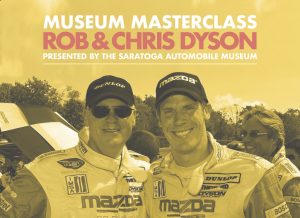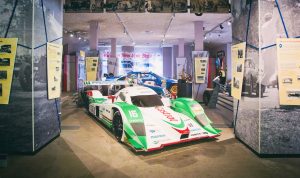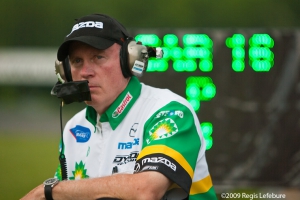MAZDA RACEWAY LAGUNA SECA
For years, we only had one “home race” a year at Lime Rock. But since we’ve linked up with Mazda, we have two. Mazda Raceway Laguna Seca is a fabulous facility and the setting near Monterey simply couldn’t be more picturesque.
You could say the same about the bulk of the race weekend. We rolled the car off the truck and it was instantly very, very good. When we raced at MRLS in late 2009, the car was lightning fast but a bit on the edge. This meant we could push, but with very little margin for error. We had to take a pretty radical approach last year with the setup, mainly to maintain heat in the tires. When we returned this year, however, the characteristics of our new Dunlops have enabled us to revert to a setup that has allowed us to drive right on the limit from the outset with confidence, and with some slip angle. Guy and I both like the car to be able to drive “elbows out,” braking late and driving hard onto the apex, and the Lola on Dunlops rewards this approach.
We cycled in our newest driving partner Andy Meyrick, who drove with us at Sebring, and I was really impressed with how quickly he managed to get right on the pace. For the first time, the MRLS event would run six hours, and since every lap is two miles of non-stop action, Guy and I were delighted to welcome Andy back.
Guy was down to qualify, and I had a great feeling about his performance even before the session started. He had been on it from the first session and before qualifying he was completely focused on extracting the best from the car. We all had confidence that he was going to give the Highcroft and Drayson entries a good run for pole.
All that being said, what happened next surprised all of us. Guy was balked early in his qualifying run by some of the Challenge cars, and in the pits we all groaned. Rather than getting upset as we all were, Guy simply put his head down and patiently waited to find a gap in the frenetic final moments of qualifying. Sometimes, watching from the pits is more stressful than actually being in the car! Guy did manage to get clear for one last shot at a time with the session’s time coming down to the wire, and we all watched expectantly for the lap to unfold as if we were twelve year-olds waiting for the final school bell to ring.
Sitting here, writing it now, I can still recall very clearly the electricity and excitement in our pitbox as we watched the predictive lap time on the telemetry unfold. The telemetry follows the car over a lap, and the pit / timing stand resembles what can best be described as a mini “mission control.” The team has the ability to monitor literally everything on the car in real time and while this limits a driver’s excuses (sorry James!), it’s an unbelievable detailed way to spectate.
Guy was up on his previous best lap, according to the telemetry, as he approached the famous corkscrew turn, a slow, 2nd gear corner that leads into a five story, flat-out drop downhill into a blind, 5th gear left-hander. It looked like it was going to be close with our Highcroft rivals at this point. But as the car thundered downhill on the telemetry and into view from the pitlane, the predictive lap time suddenly plummeted. Guy completed the lap and was on pole by a very healthy margin. We were all thrilled. The Highcroft guys, our main opposition for pole, were so unhinged late in the session that even “The Oracle” David Brabham decided to come across the start / finish line and slam on the brakes—flat spotting his tires in the process! Any time you can upset your opposition like that you just know you’ve had them. We all laughed our asses off at that story.
When we talked afterwards, Guy excitedly told Andy and me how the sensational Dunlop tires had allowed him to literally throw the car into the corkscrew as never before and commit immediately to the throttle. For a corner with bumps and a sandy exit, where we usually have to feed the accelerator in gradually to avoid wheelspin, this was really saying something. Guy said that he had then taken the blind left-hander faster than ever before, fully committed and trusting the grip of his tires. He was going to get pole no matter what, he said. Brave man, this Guy. We were all very impressed and it was Guy’s first overall pole, which delighted me. He’s been unquestionably one of the fastest drivers in the ALMS over the years and he has been in a position the past few years to be on pole, only for something weird (like a rainout session) or a red flag to get in the way. To grab the first pole at our “second home” track was really special for everyone.
The race the following day was, as is often the case with endurance contests, an incredible emotional odyssey. We were back and forth with Highcroft all day long. We would take the lead, then pit, and then Highcroft would take the lead. We lost a lap, then got the lap back. There were caution periods galore and we were able to capitalize on this and re-fuel the car at every opportunity. To maintain our pace and keep in the game with Highcroft, we were running full power levels with little regard for fuel consumption. We had no choice but to go for broke in an attempt to get ourselves in a position to win. Guy was up for it, for sure, and he was making a real charge at Marino, who’s been doing a stellar job with Highcroft this year. Sadly, a win was not to be, as Guy radioed in that he’d experienced a mechanical failure with twenty minutes to go.
Everyone on the team was crestfallen and somewhat in shock at this outcome. The sight of the car parked on the side of the road as the final laps wound down was tough to accept.
But that’s where racing is so different from any other sport. For us, a machine is the athletic equipment. Machines do experience failures from time to time and you have to accept that. You just don’t ever want it to happen when you’re in the middle of a combat situation. In baseball terms, imagine being up at bat and having a full count in a key situation, only for the bat to be pulled from your hands as the pitch is delivered. That’s what racing feels like sometimes.
It was a weekend of contrasts for sure. The joy of Saturday’s qualifying, followed by the operatic race and then a difficult conclusion. Racing can be an unbelievably cruel business and this was one of those occasions.
But as racers, we have no choice but to close the book once an event has concluded and immediately begin thinking about the next event, confident that it will be better than the last one. Monterey was a difficult pill to swallow, but we knew we had a sizeable gap in our schedule to respond.
Most importantly, we had signaled to the paddock that we were going to be a force to be reckoned with, and it was this feeling we would focus on carrying into the second half of the season. They knew we were there, all day long.
MILLER MOTORSPORTS PARK, SALT LAKE CITY
This was a strange weekend. We arrived and the car was quite good—almost too good, actually, versus our competition in the early sessions. Miller is set in the middle of the desert sands and is notoriously a changeable racing surface. It’s very “green” when it’s not been used and the surface is smooth but abrasive. This really works the tires quite hard and as a result a lot of rubber is laid down on the racing surface, making conditions quite changeable throughout the weekend.
Coming into the race, our competitors—who by now had a very healthy championship lead– had resumed the tiresome chorus about our “straight line speed advantage.” At altitude (Miller is 5000 feet above sea level), all cars lose horsepower but turbo cars lose less than normally aspirated cars. But that’s just part of the story.
Miller is not as much of a speedway-style road course as the long front straightaway would suggest, so the straight-line speed argument was really just a smoke and mirrors’ game. In fact, since it has five very tight hairpins, Miller is actually a handling track that puts a huge premium on braking, midrange torque and traction. The straight at Miller is massive, but as a percentage of the lap time it’s hardly as important as the tighter corners and midrange performance. If we had such a crushing advantage, we asked ourselves, why hadn’t we been on pole and won every race so far this year? The same sort of PR / moaning campaign happened in 2009, and like a broken record, the song remains the same. It’s gotten tiresome and more than a bit disingenuous.
Our little MZR-R engine lacks some of the lower-end grunt of the normally aspirated cars, but it makes remarkable top end power for a 2.0-liter engine, and we have trimmed the Lola aerodynamically to make the most of this. This means that we often run less downforce than our competitors (which means less drag, too), and this places a premium on our ability to manage the tires with compounds and mechanical setup. Everyone plays to their strengths, right?
Unfortunately at Miller, through the weekend the track “rubbered in” to such an extent that we were on a hard compound when we needed a softer one, and our form in the race showed this. At best, we were looking at a 3rd place finish but would have settled for 4th.
One of the ALMS’s most intriguing variables—and the one that really deserves more attention– is the tire war. Since we have different tire makers competing against each other, the tires are often a wild card that can swing the outcome of a race and really define a team’s strategy. This really spices things up and makes for another variable at each event. At Mazda Raceway, we had a clear advantage over the Michelin runners. But at Utah, it was the other way around in the race, and the Michelin cars simply had us covered. We are learning all the time about the Dunlops, and Dunlop Motorsport has been extremely involved technically with our team and developing tires for the ALMS. In that respect, you can accept the occasional whipping because in the big picture, the relationship with Dunlop is all about developing tires for the future, and doing so together. You just know there will be days when you have the upper hand when you’re in a tire war.
In the past, our team has always done its best when we are fully integrated with our technical partners, and 2010 is the first time in many years where we are truly enjoying a two-way street with every facet of the car’s package. It’s great to see our engineers excited about working with our technical partners and all parties are pushing themselves (and occasionally pushing each other) to extract the most at all times. As a driver, nothing excites you more than knowing that you have such a great operation working behind you, and this inspires tremendous confidence.
Miller, despite being only the 4th race, was the first race of what we inaccurately call “the second half” of the ALMS schedule. This is because there’s an eight-week gap between Monterey and Miller due to Le Mans. Miller was the first of five races that would occur over a seven-week period and everyone was gearing up for a long push through the summer.


